The seal of Tripoli is the official emblem of Libya's capital, Tripoli.
The seal of Tripoli is the official emblem of Libya's capital, Tripoli.
The seal's design consist of a golden ship which represent the importance of the city as a port.
Before 2011 the seal's design consisted of a ship whose sails are representative of Muammar Gaddafi's The Green Book. The waves are those of the Mediterranean sea and the castle in the background is the Assaraya al Hamraa (Red Castle).
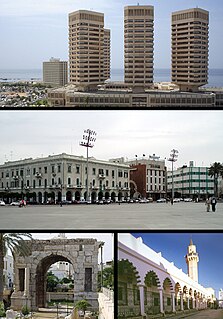
Tripoli is the capital and largest city of Libya, with a population of about 1.1 million people in 2019. It is located in the northwest of Libya on the edge of the desert, on a point of rocky land projecting into the Mediterranean Sea and forming a bay. It includes the port of Tripoli and the country's largest commercial and manufacturing center. It is also the site of the University of Tripoli. The vast Bab al-Azizia barracks, which includes the former family estate of Muammar Gaddafi, is also located in the city. Colonel Gaddafi largely ruled the country from his residence in this barracks.

The coat of arms of the Philippines features the eight-rayed sun of the Philippines with each ray representing the eight provinces which were placed under martial law by Governor-General Ramón Blanco Sr. during the Philippine Revolution, and the three five-pointed stars representing the three major island groups of Luzon, the Visayas, and Mindanao.

The First Barbary War (1801–1805), also known as the Tripolitan War and the Barbary Coast War, was the first of two Barbary Wars, in which the United States and Sweden fought against the four North African states known collectively as the "Barbary States".
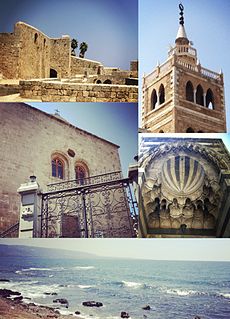
Tripoli is the largest city in northern Lebanon and the second-largest city in the country. Situated 81 km (50 mi) north of the capital Beirut, it is the capital of the North Governorate and the Tripoli District. Tripoli overlooks the eastern Mediterranean Sea, and it is the northernmost seaport in Lebanon. It holds a string of four small islands offshore. The Palm Islands were declared a protected area because of their status of haven for endangered loggerhead turtles, rare monk seals and migratory birds. Tripoli borders the city of El Mina, the port of the Tripoli District, which it is geographically conjoined with to form the greater Tripoli conurbation.
Tripoli or Tripolis may refer to:

Krak des Chevaliers, Arabic: قلعة الحصن, romanized: Qalʿat al-Ḥiṣn also called Hisn al-Akrad and formerly Crac de l'Ospital; Krak des Chevaliers or Crac des Chevaliers, is a medieval castle in Syria and one of the most important preserved medieval castles in the world. The site was first inhabited in the 11th century by Kurdish troops garrisoned there by the Mirdasids. In 1142 it was given by Raymond II, Count of Tripoli, to the order of the Knights Hospitaller. It remained in their possession until it fell in 1271.

USS President was a wooden-hulled, three-masted heavy frigate of the United States Navy, nominally rated at 44 guns. She was launched in April 1800 from a shipyard in New York City. President was one of the original six frigates whose construction the Naval Act of 1794 had authorized, and she was the last to be completed. The name "President" was among ten names submitted to President George Washington by Secretary of War Timothy Pickering in March of 1795 for the frigates that were to be constructed. Joshua Humphreys designed these frigates to be the young Navy's capital ships, and so President and her sisters were larger and more heavily armed and built than standard frigates of the period. Forman Cheeseman, and later Christian Bergh were in charge of her construction. Her first duties with the newly formed United States Navy were to provide protection for American merchant shipping during the Quasi War with France and to engage in a punitive expedition against the Barbary pirates in the First Barbary War.
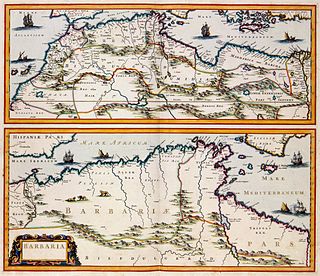
The Barbary Coast was the coastal regions of North Africa or Maghreb, specifically the Ottoman borderlands consisting of the regencies in Algiers and Tripoli, as well as the Beylik of Tunis and the Sultanate of Morocco from the 16th to 19th centuries. The term originates from the exonym of the Berbers.

The coat of arms of Gibraltar was first granted by a Royal Warrant passed in Toledo on 10 July 1502 by Isabella I of Castile during Gibraltar's Spanish period. The arms consists of an escutcheon and features a three-towered red castle under which hangs a golden key.
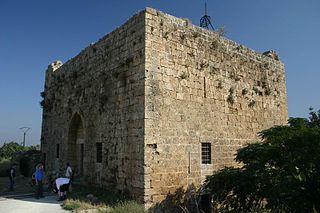
Chastel Rouge, also called Qal’at Yahmur is a small Crusader stronghold in the North West of Syria that belonged to the County of Tripoli. It is also identified as Castrum Rubrum mentioned in Latin texts. The castle stands in the village of Yahmur, at 12 kilometres' distance from Tartus and 10 kilometres from Safita, where the Tortosa and Chastel Blanc Crusader castles can be found.

The Underwater Demolition Command, abbreviated as DYK and known until 2001 as the Underwater Demolition Unit, abbreviated as MYK, is the Greek Navy's elite special warfare unit.

The Red Castle Museum, also known as As-saraya Al-hamra Museum, the Archaeological Museum of Tripoli or Jamahiriya Museum, is a national museum in Libya. It is located in the historic building known as the Red Castle of Tripoli, sometimes also referred to as Red Saraya, on the promontory above and adjacent to the old-town district with medina Ghadema.

The siege of Tripoli occurred in 1551 when the Ottoman Turks and Barbary pirates besieged and vanquished the Knights of Malta in the Red Castle of Tripoli, modern Libya. The Spanish had established an outpost in Tripoli in 1510, and Charles V remitted it to the Knights in 1530. The siege culminated in a six-day bombardment and the surrender of the city on 15 August.

A hulk was a type of medieval sea craft, a technological predecessor of the carrack and caravel. The hulk appears to have remained a relatively minor type of sailing ship apparently peculiar to the Low Countries of Europe where it was probably used primarily as a river or canal boat, with limited potential for coastal cruising. The only evidence of hulks is from legal documents and iconography.

The Martyrs' Square ; known as Green Square under the Gaddafi government; Independence Square during the monarchy; and originally known as Piazza Italia is a downtown landmark at the bay in the city of Tripoli, Libya. The main commercial center of the city surrounds the square. The Square is also a main tourist attraction in Tripoli. It has a large legendary fountain done by an Italian architect at the centre of the square. The square is the meeting point of many different avenues. Omar Mukhtar Avenue is one of the longest in North Africa, it was built by Italians in the colonial time, and Libyans during the era of King Idris I. Independence Street branches from the square too, and it leads to the Palace of King Idris I. 24 December Avenue is also an Italian built avenue. Mizran Street is the last street that branches from the Martyrs' Square.

USS Tripoli (LHA-7) is the second America-class amphibious assault ship built for the United States Navy. On 7 May 2012, United States Secretary of the Navy Ray Mabus announced the ship's name as Tripoli, in honor of the US Marine Corps victory against Tripoli at the Battle of Derna during the First Barbary War. This is the third US Naval ship to carry the name, the first being USS Tripoli (CVE-64), an escort carrier from World War II and the second being USS Tripoli (LPH-10), an amphibious assault ship that served during the Cold War.
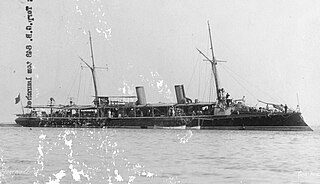
Tripoli was the first modern torpedo cruiser built for the Italian Regia Marina. She was built by the Regio Cantiere di Castellammare di Stabia shipyard in 1885–86. The only vessel of her class, she provided the basis for the Goito and Partenope classes that followed. She was armed with five 14-inch (356 mm) torpedo tubes and a battery of light guns, and was capable of a top speed of 17.5 knots. Tripoli spent her career in the main Italian fleet, where she was occupied primarily with peacetime training exercises. She was modernized several times throughout her career, and in 1910, was converted into a minelayer, a role she served in for another thirteen years, including during World War I. She was the longest serving torpedo cruiser in the Italian fleet, with over 36 years in service by the time she was discarded in March 1923.
The Conquest of Tripoli was a maritime campaign led by Pedro Navarro which captured the city of Tripoli in North Africa in the name of the Crown of Aragon in 1510.

The Red Castle, in Arabic As-saraya Al-hamra, sometimes also Red Fort or Red Saraya, is a major landmark on the waterfront of Tripoli, bordering Martyrs' Square. It has been the home of the Red Castle Museum since 1919, and of the Libyan Department of Archaeology since 1952.

The seal and flag were the symbols of the Panama Canal Zone, an unincorporated territory of the United States, that existed from 1903 to 1979. The seal was adopted in 1906, and the flag in 1915. They were used until 1 October 1979, when the territory ceased to exist.